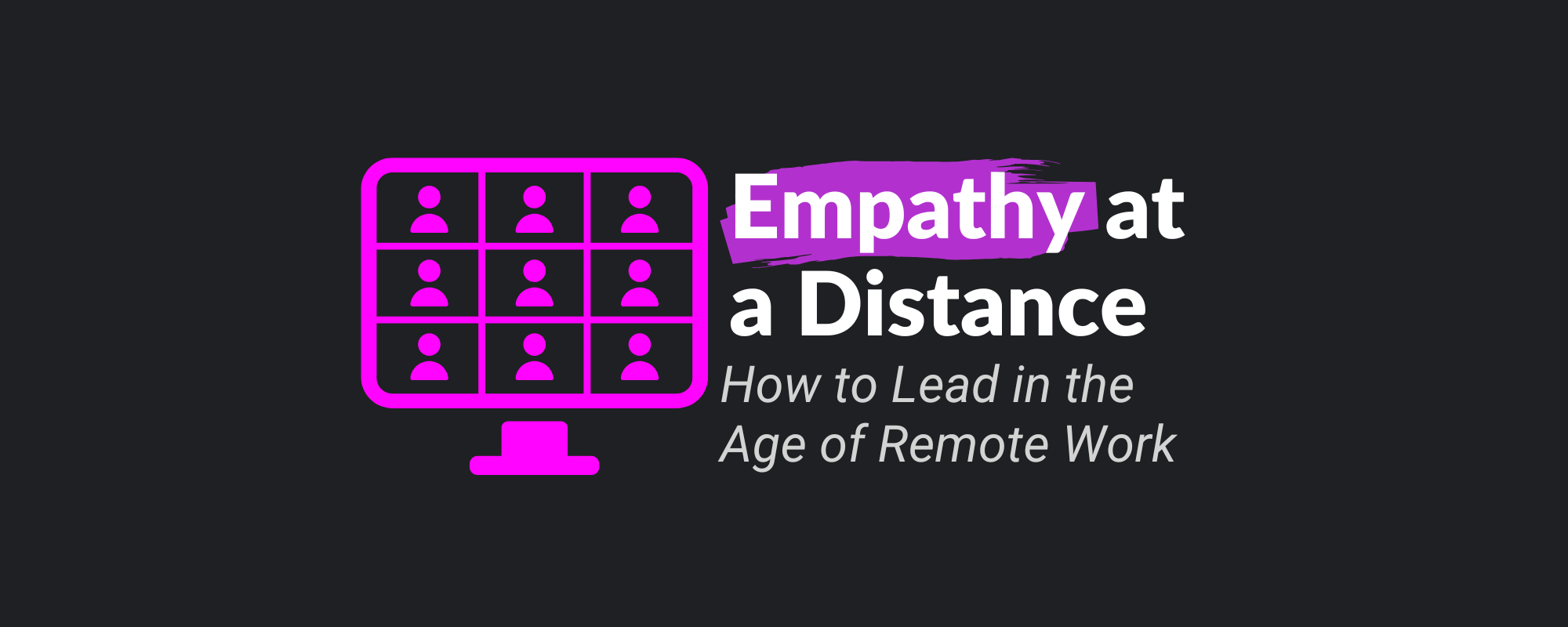Empathy at a Distance: How to Lead in the Age of Remote Work

It's 9 AM, and you're not stuck in traffic. You're not worrying about where to grab your morning coffee before a big meeting. You're home, probably a bit more comfortable, wearing slippers, and your morning commute is merely a walk to your desk. The world has shifted. Leadership has shifted. And if it hasn’t yet for you, it’s only a matter of time. Remote work isn't a trend—it's a paradigm shift, one that's here to stay. And with this shift comes a new leadership challenge: balancing the incredible efficiency that technology offers with the irreplaceable warmth of genuine human connection.
For many, remote work has peeled back the layers of what we thought leadership was. It's easy to lead a team of people when you can peek over their shoulders. It's harder when the only thing you can peek at is their profile picture on Slack. It makes one reconsider what leadership really means, doesn’t it?
The Balancing Act
Think of a team leader trying to navigate this remote landscape, armed with Zoom calls, Slack pings, and productivity metrics. Sure, everything looks efficient on the surface. The digital engine of modern work is firing on all cylinders. But there’s a catch. The team feels disconnected, isolated even, lost in a haze of instant messages and back-to-back calls. Technology, in all its convenience, can't replicate the subtle energy of human presence. You can't shake hands over a video call. You can't catch the fleeting smile of a team member after a job well done. You can't truly know how someone feels with just an emoji.
That’s where the real balancing act begins. Remote leadership requires the careful use of technology—not as a substitute for real connection but as a bridge to facilitate it. Tools like Zoom and Microsoft Teams are great, but they must be wielded with care. It's not about how many meetings you have, but about how well you connect in the ones that you do. Over-reliance leads to burnout. Under-reliance leads to silence. The key? Understanding which gaps tech can fill and which are best left to human warmth.
The Middle East, particularly the UAE and KSA, showcases a unique take on this transition. In regions that value close-knit relationships, hospitality, and face-to-face interactions, finding the right mix is even more challenging. Yet, what we’ve seen in these places is inspiring—a commitment to adapting, to embracing the new while staying rooted in tradition.
The Heartbeat of Remote Leadership
Leading from afar means you have to work harder to show you care. Empathy isn’t optional. It's not the latest management buzzword; it's the heartbeat of effective leadership. In a world where most conversations happen in digital spaces, leaders have to be intentional about showing empathy. Checking in with your team—genuinely, not just as a box-ticking exercise—matters more now than ever.
Take the UAE, for example. Here, 80% of employees express confidence in their leaders’ ability to fulfill promises—higher than the global average of 68%[1]. This kind of confidence doesn't happen by accident. It's nurtured by leaders who are present for their people, even if "being there" is just a video call away. Empathy translates across any medium, provided it's real.
But how does a leader actually foster empathy? One-on-one check-ins are a good start. This isn't about micromanaging or ensuring the work gets done. It's about knowing your people. Ask them about their day, their challenges, their wins. Turn on your camera during meetings—not because it’s company policy, but because making eye contact (even virtually) creates that human touch that bridges the gap. Plus, people are more likely to smile back when they see you smile first. Make it personal, make it real. Remote work doesn't eliminate humanity; it just challenges you to be more deliberate in connecting with it.
Flexibility: The New Currency of Trust
The remote environment has also redefined productivity. It’s not about sitting in front of a screen for eight hours straight. It’s about outcomes. Rigid schedules, the "9-to-5," are relics of the past. We now live in a time where flexibility is the currency of trust. According to PwC’s Middle East Workforce Hopes and Fears Survey 2024, 81% of workers in the region say they work remotely with their employers’ approval[2]. This is significant. It signals a high level of trust between employees and leaders—trust that acknowledges the complexities of life outside work.
Take an example from a company in Dubai. The CEO, recognizing the changing dynamics of her team's life commitments, allowed for staggered start times. What mattered was not when people started working, but how they delivered. Flexibility, in this case, wasn’t a favor—it was an acknowledgment that productive, happy employees are those whose leaders trust them enough to manage their own time.
Trust is central. Letting go of micromanagement, allowing team members to structure their day in a way that works for them—this is leadership in the new age. It's about setting clear goals, but then stepping back, believing your people will meet them.
Beyond the Virtual Happy Hour
Ah, the virtual happy hour—a concept that started out charming, but now feels a bit like reheating last night's leftovers for the third time. It was great once, but we can do better. Team spirit is vital, but keeping it alive remotely takes creativity, not gimmicks. Maintaining team spirit means engaging people in ways that feel authentic, rather than obligatory.
Middle Eastern organizations, often culturally bound by deep-rooted hospitality and community values, have shown some inspiring examples here. Consider a Riyadh-based firm that moved beyond trivia nights to something more meaningful: virtual talent shows where team members could share skills or passions outside of work. A software engineer showed off his baking skills, while a designer took everyone through a ten-minute yoga session. These aren’t just activities—they’re bridges. Bridges between work personas and the real people behind them.
In the UAE, 90% of the workforce prefers hybrid or fully remote work[3]. This isn’t just about convenience—it’s about well-being, about having a sense of control. As a leader, recognizing this preference and adapting engagement strategies accordingly isn't just good for morale; it’s good for business. Motivation, after all, thrives where there is autonomy.
Tools that Enable, Without Overwhelming
We’ve all experienced Zoom fatigue. It’s that glazed-over feeling after too many back-to-back virtual meetings, the sense that you’re always "on." Leaders must understand that productivity tools can be a double-edged sword. Used well, they enable great work. Misused, they stifle creativity and leave people exhausted.
The Middle East is at the forefront of adopting AI and other digital tools to boost work efficiency—81% of employees in the region have used GenAI at work in the past year, compared to 61% globally[4]. This rapid adoption is driven by both cultural and economic factors. Economically, the region has invested heavily in technological infrastructure as part of broader visions like Saudi Arabia's Vision 2030 and the UAE's national AI strategy. Culturally, there is a strong emphasis on modernization and being at the cutting edge, which encourages the use of advanced technology to improve productivity and efficiency. The opportunity is vast, but so is the risk. Leaders need to be thoughtful about when to use these tools and when to let people work on their own terms. Asynchronous communication, for example, can be a gift to productivity. It removes the pressure of always being immediately available, allowing deeper, more thoughtful work.
Instead of a five-person Zoom meeting at 9 AM, what if everyone shared their updates in a short video or a voice note? People could listen in on their own schedule, respond thoughtfully, and avoid the drain of too much screen time. The tools are there, but it’s all about wielding them wisely—using them to empower, not to exhaust. Remember, nobody wants their workday to feel like a never-ending cycle of video calls and notifications.
The Evolution of Leadership
If there’s one thing this remote age has taught us, it’s that leadership isn’t about being in control—it’s about being supportive. The world has shifted, and with it, the expectations of leaders have changed. The office may be kilometers away, but that doesn’t mean your influence has to be. Instead of managing tasks, remote leadership is about managing energy, empathy, and connections.
The journey? Far from straightforward. It's messy, human, and full of missteps. But that’s where the real growth happens. For instance, one common challenge is managing the blurred boundaries between work and personal life in a remote setting. Many leaders initially tried to replicate the in-office schedule, only to find that it led to burnout and disengagement. Adapting to a flexible model required listening to their teams and iterating on schedules and expectations. But it’s also the type of leadership that people will remember. Not for how many Zoom meetings you held or how efficiently you tracked project progress, but for how you made them feel supported in a time that felt, for many, completely uncertain.
Khaldoon Al Mubarak, CEO of Mubadala, said it best: “In a rapidly changing world, leaders must be agile and responsive to new challenges.”[5] Remote leadership is one of those challenges. And just like any challenge, it comes with opportunities—opportunities to inspire, to innovate, to build a team that doesn’t just work together, but truly feels together.
Leadership in the remote era is about adaptability, empathy, and connection. It’s about realizing that, at its heart, leadership hasn’t changed—it’s still about people. Remote or not, people are still what make organizations thrive.
[1] PwC Middle East Workforce Hopes and Fears Survey 2024. https://www.pwc.com/m1/en/issues/pdf/me-workforce-hopes-and-fears-survey-2024.pdf
[2] PwC Middle East Workforce Hopes and Fears Survey 2024. https://www.pwc.com/m1/en/issues/pdf/me-workforce-hopes-and-fears-survey-2024.pdf
[3] Matsh. Remote work statistics in the Gulf region. https://www.matsh.co/en/remote-work-statistics-in-the-gulf-region/
[4] GulfTalent. Remote work trends in the Gulf. https://www.gulftalent.com/resources/employment-news/remote-work-trends-in-the-gulf-97
[5] Wikipedia. Remote work. https://en.wikipedia.org/wiki/Remote_work



Discussion